Volcano Live
volcanolive.com
Mt Vesuvius Volcano | John Seach

Campania, Italy
40.82 N, 14.43 E,
summit elevation 1281 m,
Complex volcano
Mount Vesuvius is a stratovolcano located on the Gulf of Naples, in southern Italy. It is best known for its eruption in AD 79, which buried the Roman cities of Pompeii, Herculaneum, Stabiae, and other communities, and resulted in the deaths of an estimated 16,000 people.
Vesuvius is considered to be one of the most dangerous volcanoes in the world due to its proximity to the densely populated cities of the Campanian Plain, including Naples. The most recent eruptive activity at Vesuvius occurred in 1944, which was characterized by explosive eruptions, ash emissions, and pyroclastic flows. This activity was relatively minor and caused no significant damage or loss of life.
Since then, Vesuvius has been in a dormant phase, but scientists consider it to be a "restless" volcano, as it has shown signs of low-level activity such as ground deformation, changes in gas emissions, and minor earthquake swarms. This means that Vesuvius has the potential to erupt again in the future and could pose a significant hazard to the population living nearby. Mount Vesuvius is one of the most studied volcanoes in the world, due to its historical significance and potential threat to the population.
Scientists use various monitoring techniques such as GPS, InSAR, gas monitoring, and thermal imaging to understand the volcano's behavior and to predict potential hazards.
Mt Vesuvius volcano photos by John Seach
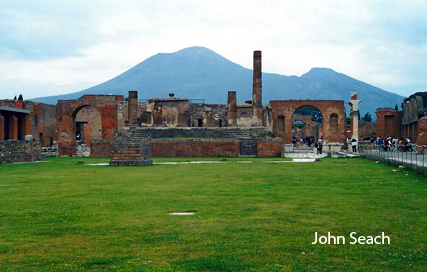
Mt Vesuvius volcano from Pompeii
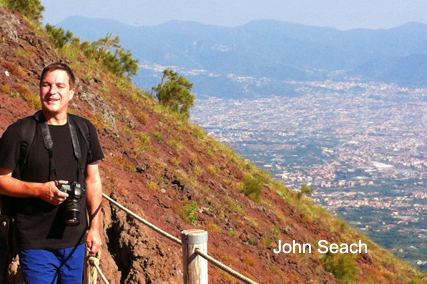
Mt Vesuvius 2013
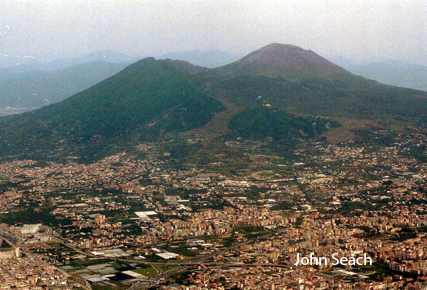
Mt Vesuvius and Napoli
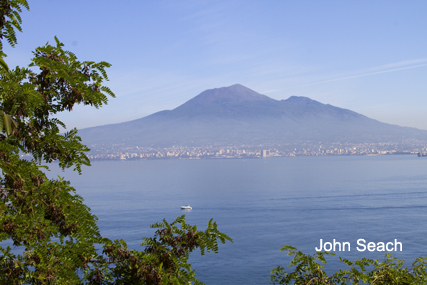
Mt Vesuvius volcano
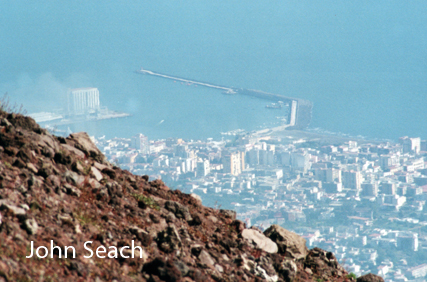
Flank of Mt Vesuvius and Napoli.
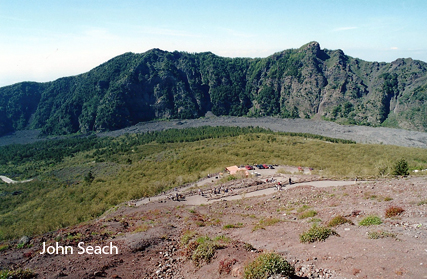
Mt Vesuvius caldera
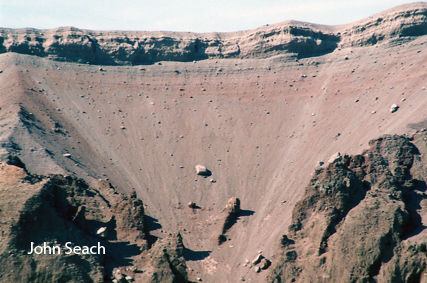
Mt Vesuvius crater
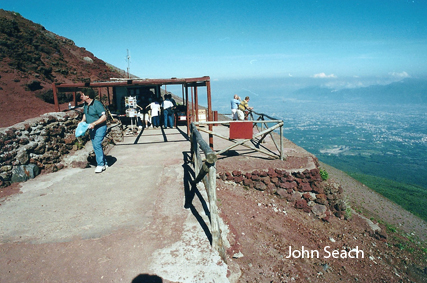
Mt Vesuvius
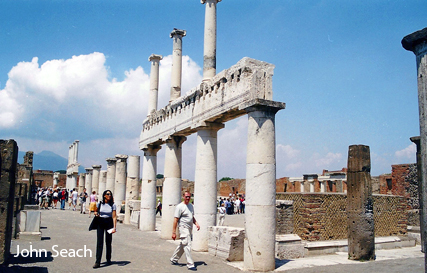
Pompeii
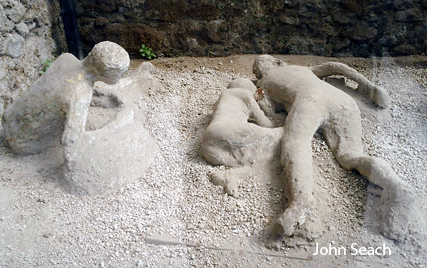
Victims of 79AD eruption of Vesuvius at Pompeii
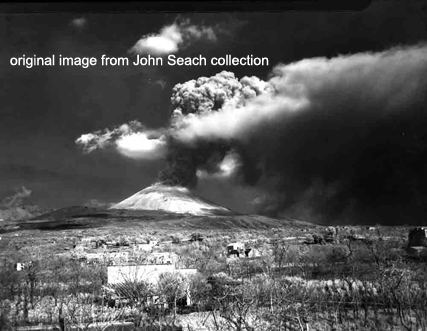
Mt Vesuvius eruption 1944 - original image from John Seach collection
In 79 AD an eruption of the volcano destroyed Pompeii and its remains are a popular tourist attraction south of Napoli. In recent years there has been an attempt to relocate some resident from the slopes of the volcano to reduce the risk from the next eruption.
A Tour of Pompeii.
The Eruption
of 79 AD.
1999 Earthquake Swarm
Since 1944, seismicity at Mt Vesuvius has been marked by moderate-energy events with a frequency of a few hundred per year. At 7:41 am local time on 9th October 1999 a magnitude 3.6 earthquake hit Mt Vesuvius, as part of the largest earthquake swarm since 1944. The earthquake was felt in a 25 km radius of the volcano. This earthquake was the same size as the precursor of the great 1631 eruption.
1944 Eruption
A two week long eruption of Mt Vesuvius volcano began on 18th March 1944 with a lava flow from the summit crater. Eruptions changed to explosive activity on 21st March with eight lava fountains. The lava fountains increased with time, and the last one on 22nd March was the most intense, reaching heights of 1000 m. A transition to mixed magmatic–phreatomagmatic activity was marked by emissions of ash columns. The final phase of activity at Vesuvius began on 23rd March with vulcanian activity and nuées ardentes. The eruption finished on 29th march 1944. This ended nearly 300 years of semi persistent activity of Vesuvius.
A shallow and deep magma reservoir was involved in the 1944 eruption of Mt Vesuvius volcano; depths of less than 3 km deep and 11-22 km. The shallow reservoir feeding the 1944 eruption was completely emptied and collapsed during the final phases of the eruption. The eruptions in 1944 and 1906 were similar in terms of rock compositions, eruptive style, and erupted volumes.
1906 Eruption
An eruption began at Mt Vesuvius on 4th April 1906 when an effusive vent opened on the southern slope at an altitude of 1200 m, near Casotto delle Guide. At midnight on 4th April the lava flow ceased when a new fracture opened up near the cistern of Casa Fiorenza at an elevation of about 800 m elevation. At about 8:00 a.m. on 6th April a third vent opened near Bosco Cognoli at 600 m altitude on the same fracture zone. Lava flow of Bosco Cognoli was much more fluid than those of the preceding days and continued until the evening of 7th April.
From the morning of 4th April explosions of progressively increasing intensity and frequency occurred at the central crater of Vesuvius. Ash plumes reached a height of 2000-3000 m. After 6th April there was a relative lowering of sea level, of about 50 cm, on the shoreline between Torre del Greco and Torre Annunziata, together with the opening of new fractures, which indicated inflation of the volcano.
On the afternoon of 7th April the activity at the central crater of Vesuvius became stronger, with increasingly violent and frequent explosions. Intense lava fountains were visible during the evening of 7th April. At 10:00 pm a break in the crater rim resulted in the lava fountains beginning "... shoot more and more obliquely
to the northeast till it formed a giant arch over spanning the crest of Monte Somma in the direction of Ottajano ..."
At 3:30 am in the morning on 8th April the eruption at Vesuvius changed from lava fountains to extremely violent explosions. The upper part of the cone opened "like the falling of the petals of a flower and were expelled in all directions. Over a 30 hour period the eruption looked like a huge persistent geyser. Lapilli fell in a radius of 6 km from the crater.
The final phase of the 1906 eruption of Vesuvius consisted of emission of large from the central crater with low pressure, and low eruptive clouds over the volcano. The eruption finished on 21st April 1906.
1872 Eruption
On 26th April 1872 an eruption began at Vesuvius with lava flowing from a fissure on the northwestern side of the mountain. The lava blocked the escape route for 20 spectators who were killed. The lava flow forked at Observatory Hill. One flow passed through Fossa della Vetrana and Fossa Faraone and destroyed the inhabited centres of Masa and S Sebastiano al Vesuvio. The second fork of the lava flow surrounded the Volcano Observatory and stranded staff for days. On the 28th April when the lava flow stopped there were spectacular eruptions at the summit. There was a crater collapse on 1st May forming a caldera.
1861 Eruption
A series of earthquakes preceded an eruption of Vesuvius on 6th December 1861. A fracture opened 2 km NE of Torre del Greco, and could be seen from the sea. Eruptive vents opened on the upper part of the fracture killing one woman. Lava flowed towards Torre del Greco and Herculanem until the end of December and destroyed several houses. The coastline rose up to one metre. Carbon dioxide emissions occurred in wells and cellars.
1858-61 Eruption
On 28th May 1858 lava flowed from six fissured on the northwest side of Mt Vesuvius volcano. Lava continued to flow until 1861 and reached Fosso Grande, Piano delle Ginestre and Fosso della Vetrana.
1834 Eruption
An eruption of Vesuvius began on 23rd August 1834 and discharged a large amount of lava. On 24th August a new vent opened on the eastern side of the volcano at Grotta del Mauro, in the location of the 1817 lava flow. On 27th August a lava flow moved towards Mauro, widening as it descended, and reached a width of half a mile, and a depth of 18 feet. The lava flow destroyed 180 houses, leaving 800 people homeless, and covered 500 acres of land. Towards the end of the eruption of Vesuvius fish died in a private pond at Puzzuoli. The main victims belonged to bottom dwelling species.
1794 Eruption
An explosion occurred at the summit of Mt Vesuvius on 15th July 1794. A lava flow reached Torre del Greco at 6:00 am the following morning destroying a large part of the town.
1760 Eruption
On 27th December 1760 a fracture opened up 3 km northwest of Boscotrecase on the southern side of Vesuvius. Fifteen vents opened and effused a large amount of lava. The cone of the central crater collapsed on 29th December diminishing the eruption.
1631 Eruption
On 10th December 1631 residents of Torre del Greco stated
they heard the mountain roaring from
the inside, with such a stirring of subterranean
spirits, that they could hardly sleep at all during
the night. This was the first activity at Mt Vesuvius in 500 years. A large eruption of Mt Vesuvius began at dawn on 16th December 1631. A Plinian column erupted up to 28 km high accompanied by tephra fallout for a few hours. Tephra fallout occurred on the eastern side of the volcano, sparing Naples. This was followed by pyroclastic flows, phreatomagmatic ash emission and secondary lahars. Spectacular lava flows began on 18th December 1631. Eruptions ceased by the end of December. Moderate plinian eruptions at Vesuvius like those of 1631 and 472 require periods of repose of the order of centuries and have always been explosive.
Further reading
Gurioli, L., Houghton, B.F., Cashman, K.V. and Cioni, R., 2005. Complex changes in eruption dynamics during the 79 AD eruption of Vesuvius. Bulletin of Volcanology, 67(2), pp.144-159.
Principe, C., Tanguy, J.C., Arrighi, S., Paiotti, A., Le Goff, M. and Zoppi, U., 2004. Chronology of Vesuvius’ activity from AD 79 to 1631 based on archeomagnetism of lavas and historical sources. Bulletin of Volcanology, 66(8), pp.703-724.
Sigurdsson, H., Cashdollar, S. and Sparks, S.R., 1982. The eruption of Vesuvius in AD 79: reconstruction from historical and volcanological evidence. American journal of archaeology, pp.39-51.
Sheridan, M.F., Barberi, F., Rosi, M. and Santacroce, R., 1981. A model for Plinian eruptions of Vesuvius. Nature, 289(5795), pp.282-285.
Mt Vesuvius Volcano Eruptions
1913-44, 1875-1906, 1874, 1870-72, 1864-68, 1855-61, 1854-55, 1841-50, 1835-39, 1824-34, 1796-1822, 1783-94, 1770-79, 1764-67, 1744-61, 1732-37, 1724-30, 1712-23, 1708, 1706-07, 1701-04, 1697-98, 1696, 1685-94, 1682, 1654-80, 1637-52, 1631-32, 1139, 1073, 1049?, 1037, 1007, 999?, 991?, 968, 787, 685, 536, 512, 505, 472, 379-95, ?222-35, 203, 172, 79 AD, 1500BC.